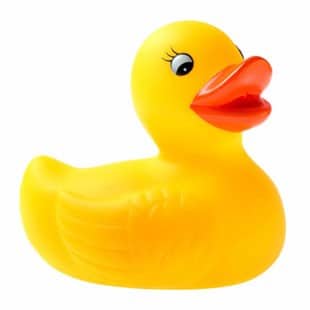Assignment 1, Rhetorical Analysis: Rubber Ducks

(The Strong)
A classic rubber duck is approximately 1.5 inches high by 2.5 inches wide. The one who sits on my bathroom counter is yellow, with an orange beak, black and white eyes, and three eyelashes per eye. Though they’re known as rubber ducks, according to The Strong National Museum of Play, these days, “the iconic floating yellow figure with bright orange bill” is typically made of vinyl. The Strong calls rubber ducks “the quintessential bathtub toy” that appeals to kids and adults alike through “good clean fun.” With their cheerful, colorful appearances inspired by ducklings (the only yellow ducks), the ubiquitous rubber ducks make fun companions for bathing kids and provide simple, infinitely-personalizable kitsch for adults.
“Good clean fun” represents the theme of The Strong’s entry on rubber ducks; it’s part of a series on the museum’s website for The National Toy Hall of Fame. Rubber ducks’ inclusion in the series indicates the ubiquity of these bath toys, but the website also provides a history for the object, demonstrating their cultural significance—something that would be easy to overlook for objects that are so popular they get taken for granted as fixtures in our everyday lives (and bathrooms). Both the museum exhibit and the entry on rubber ducks will appeal to adults interested in children’s culture who want to learn the unique history of childhood icons.
While The Strong National Museum of Play and The National Toy Hall of Fame add credibility to the information about rubber ducks, the entry also references Ernie’s famous “Rubber Duckie” song that debuted on Sesame Street in 1970 (The Strong). If audience members don’t yet have the song stuck in their heads, the familiar, wholesome appeal of a show like Sesame Street and the lovable Muppet character Ernie are likely to inspire trust. That ethos is supported by examples of logos throughout the entry. The Strong traces the history of the rubber duck, from its inception in “the late 1800s” to its “iconic” form in the 1940s to the Sesame Street song that reached number 16 on the Billboard charts to its inclusion in the museum in 2013. These examples of logos demonstrate the longevity of rubber ducks as well as their enduring, unchanging image for decades. Perhaps the popularity of the rubber duck lies in its simplicity—a universal, happy character beloved by generations.
Certainly The Strong entry reveals a number of values rubber ducks embody. As a bath toy, the rubber duck promotes healthy child development as it “develops muscle strength and coordination” (The Strong). They also “sharpen toddlers’ senses” (The Strong). In further pursuit of healthy children (a value emphasized by the museum entry), rubber ducks provide calm education about personal hygiene; as The Strong says, “[t] heir presence in the bathtub soothes youngsters’ fears of water and water immersion and makes good clean fun of the routine hygiene they’re learning.” And, since they’re toys, rubber ducks are also supposed to be fun and inspire play. Alluding to the Sesame Street song, The Strong writes that “kids still sing the praises of their water play pals.” I think the big-eyed, duckling-hued toys continue to appeal to kids because they’re cute and happy; they draw on children’s love of animals and allow kids in the bath to mimic the actions of real ducks, animals typically seen as familiar and endearing. By making the ducks look like ducklings, there’s a sense of neoteny that promotes playfulness and care for kids and adults.
Adults love rubber ducks, too, The Strong assures its audience, as “[c]ollectors proudly display variations of the classic form that proclaim their affinity to colleges, careers, sports, celebrities, and holidays. Aficionados adorn their homes with rubber duck–themed shower curtains, towels, bathrobes, nightlights, and wallpaper.” Maybe rubber ducks appeal to so many adults because they recall a simpler time of being loved and cared for in the bath, or of taking care of beloved children. So, the next time you notice a rubber duck smiling in the bathroom, remember, it’s not really rubber and it’s not just a duck. It’s a symbol of childhood: happy, healthy, simple, and filled with wonder at everyday objects like a yellow toy duck.
Work Cited
The Strong National Museum of Play. “Rubber Duck.” The National Toy Hall of Fame,
2013, www.toyhalloffame.org/toys/rubber-duck. Accessed 23 July 2019.
